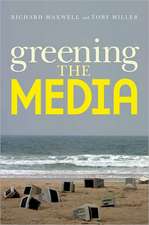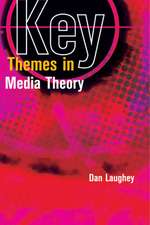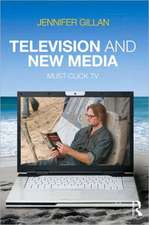The New Media and Technocultures Reader
Editat de Seth Giddings, Martin Listeren Limba Engleză Paperback – 10 feb 2011
The New Media & Technocultures Reader offers students further reading on and exploration of key issues and topics raised in the textbook New Media: A Critical Introduction. The Reader draws on various disciplinary stances (including visual culture; media and cultural history; media theory; media production; philosophy and the history of the sciences; political economy and sociology), offering readers a rich and interdisciplinary resource. Critical and accessible editorial commentary guides the reader between the extracts and through the debates.
| Toate formatele și edițiile | Preț | Express |
|---|---|---|
| Paperback (1) | 328.87 lei 6-8 săpt. | |
| Taylor & Francis – 10 feb 2011 | 328.87 lei 6-8 săpt. | |
| Hardback (1) | 832.26 lei 6-8 săpt. | |
| Taylor & Francis – 14 feb 2011 | 832.26 lei 6-8 săpt. |
Preț: 328.87 lei
Preț vechi: 384.26 lei
-14% Nou
Puncte Express: 493
Preț estimativ în valută:
62.93€ • 65.70$ • 52.08£
62.93€ • 65.70$ • 52.08£
Carte tipărită la comandă
Livrare economică 04-18 aprilie
Preluare comenzi: 021 569.72.76
Specificații
ISBN-13: 9780415469142
ISBN-10: 0415469147
Pagini: 528
Ilustrații: figures
Dimensiuni: 174 x 246 x 28 mm
Greutate: 0.93 kg
Ediția:1
Editura: Taylor & Francis
Colecția Routledge
Locul publicării:Oxford, United Kingdom
ISBN-10: 0415469147
Pagini: 528
Ilustrații: figures
Dimensiuni: 174 x 246 x 28 mm
Greutate: 0.93 kg
Ediția:1
Editura: Taylor & Francis
Colecția Routledge
Locul publicării:Oxford, United Kingdom
Public țintă
Postgraduate and UndergraduateCuprins
Acknowledgements
Permissions
Introduction
PART 1: Genealogies of Technoculture
1.1 The first and second industrial revolution
Norbert Wiener
1.2 The ontology of the enemy: Norbert Wiener and the cybernetic vision
Peter Galison
1.3 Dazzling the multitude: original media spectacles
Carolyn Marvin
1.4 Selected material from Computer Lib / Dream Machines
Ted Nelson
1.5 From Kaleidoscomaniac to cybernerd: Towards an archaeology of the media
Erkki Huhtamo
1.6 Introduction to War in the Age of Intelligent Machines
Manuel de Landa
PART 2: Models of Technology, Media and Culture
2.1 The labour process and alienation in machinery and science
Karl Marx
2.2 Selected material from Understanding Media: the extensions of man (‘The medium is the message’, ‘Media as translators’, ‘The typewriter’)
Marshall McLuhan
2.3 The technology and the society
Raymond Williams
2.4 The proliferation of hybrids
Bruno Latour
2.5 The vanishing point of communication
Jean Baudrillard
2.6 ‘The informatics of domination’ and ‘Women in the integrated circuit’ from A Cyborg Manifesto
Donna Haraway
2.7 Balance program for desiring machines
Feliz Guattari
PART 3: Bodies and Agents
3.1 Where are the missing masses? The sociology of a few mundane artifacts
Bruno Latour
3.2 Cyborgs, coyotes and dogs: a kinship of feminist figurations / there are always more things going on than you thought: methodologies as thinking technologies
Donna Haraway
3.3 Feedback and cybernetics: reimaging the body in the age of the cyborg
David Tomas
3.4 Creatures on the Internet
Sarah Kember
3.5 Intelligent Agency
J. Macgregor Wise
3.6 Female Quake players and the politics of identity
Helen Kennedy
PART 4: Texts, Forms, Codes
4.1 Virtuality
Benjamin Woolley
4.2 Interactivity
Pierre Levy
4.3 The adventure game
Espen Aarseth
4.4 Selected material from The Language of New Media (‘The database’ and ‘Navigable space’)
Lev Manovich
4.5 Invisible media
Laura U. Marks
4.6 Theses on distributed aesthetics
Geert Lovinck
4.7 "Hacking" the iPod: A Look Inside Apple’s Portable Music Player
Gabrielle Consentino
4.8 Listening in cyberspace
Mark Katz
4.9 Hybrid Cinema: The Mask, Masques and Tex Avery
Norman Klein
4.10 Photography in the age of electronic imaging
Martin Lister
4.11 ‘Eyeball’ from Pilgrim in the Microworld: eye, mind and the essence of video skill
David Sudnow
PART 5: Network Culture
5.1 Trading sexpics on IRC : embodiment and authenticity on the internet
Don Slater
5.2 Free labour
Tiziana Terranova
5.3 Gaming lifeworlds: social play in persistent environments
T.L. Taylor
5.4 Technoscience in hypertext
Donna Haraway
5.5 Updating tactical media
Geert Lovinck
5.6 Indymedia.org: a new communications commons
Dorothy Kidd
PART 6: Everyday Media Technocultures
6.1 The domestic ecology of objects
Elaine Lally
6.2 Domesticating New Media: A discussion on locating mobile media
Larissa Hjorth
6.3 Bergson’s iPod? The cognitive management of everyday life
Michael Bull
6.4 Everyday (virtual) life
Mark Poster
6.5 Japan’s mobile technoculture: the productions of a cellular playscape and its cultural implications
Michal Daliot-Bul
6.6 Playspaces, childhood and videogames
Shanly Dixon & Sandra Weber
6.7 Mobilizing imagination in everyday play: the case of Japanese media mixes
Mizuko Ito
Index
Permissions
Introduction
PART 1: Genealogies of Technoculture
1.1 The first and second industrial revolution
Norbert Wiener
1.2 The ontology of the enemy: Norbert Wiener and the cybernetic vision
Peter Galison
1.3 Dazzling the multitude: original media spectacles
Carolyn Marvin
1.4 Selected material from Computer Lib / Dream Machines
Ted Nelson
1.5 From Kaleidoscomaniac to cybernerd: Towards an archaeology of the media
Erkki Huhtamo
1.6 Introduction to War in the Age of Intelligent Machines
Manuel de Landa
PART 2: Models of Technology, Media and Culture
2.1 The labour process and alienation in machinery and science
Karl Marx
2.2 Selected material from Understanding Media: the extensions of man (‘The medium is the message’, ‘Media as translators’, ‘The typewriter’)
Marshall McLuhan
2.3 The technology and the society
Raymond Williams
2.4 The proliferation of hybrids
Bruno Latour
2.5 The vanishing point of communication
Jean Baudrillard
2.6 ‘The informatics of domination’ and ‘Women in the integrated circuit’ from A Cyborg Manifesto
Donna Haraway
2.7 Balance program for desiring machines
Feliz Guattari
PART 3: Bodies and Agents
3.1 Where are the missing masses? The sociology of a few mundane artifacts
Bruno Latour
3.2 Cyborgs, coyotes and dogs: a kinship of feminist figurations / there are always more things going on than you thought: methodologies as thinking technologies
Donna Haraway
3.3 Feedback and cybernetics: reimaging the body in the age of the cyborg
David Tomas
3.4 Creatures on the Internet
Sarah Kember
3.5 Intelligent Agency
J. Macgregor Wise
3.6 Female Quake players and the politics of identity
Helen Kennedy
PART 4: Texts, Forms, Codes
4.1 Virtuality
Benjamin Woolley
4.2 Interactivity
Pierre Levy
4.3 The adventure game
Espen Aarseth
4.4 Selected material from The Language of New Media (‘The database’ and ‘Navigable space’)
Lev Manovich
4.5 Invisible media
Laura U. Marks
4.6 Theses on distributed aesthetics
Geert Lovinck
4.7 "Hacking" the iPod: A Look Inside Apple’s Portable Music Player
Gabrielle Consentino
4.8 Listening in cyberspace
Mark Katz
4.9 Hybrid Cinema: The Mask, Masques and Tex Avery
Norman Klein
4.10 Photography in the age of electronic imaging
Martin Lister
4.11 ‘Eyeball’ from Pilgrim in the Microworld: eye, mind and the essence of video skill
David Sudnow
PART 5: Network Culture
5.1 Trading sexpics on IRC : embodiment and authenticity on the internet
Don Slater
5.2 Free labour
Tiziana Terranova
5.3 Gaming lifeworlds: social play in persistent environments
T.L. Taylor
5.4 Technoscience in hypertext
Donna Haraway
5.5 Updating tactical media
Geert Lovinck
5.6 Indymedia.org: a new communications commons
Dorothy Kidd
PART 6: Everyday Media Technocultures
6.1 The domestic ecology of objects
Elaine Lally
6.2 Domesticating New Media: A discussion on locating mobile media
Larissa Hjorth
6.3 Bergson’s iPod? The cognitive management of everyday life
Michael Bull
6.4 Everyday (virtual) life
Mark Poster
6.5 Japan’s mobile technoculture: the productions of a cellular playscape and its cultural implications
Michal Daliot-Bul
6.6 Playspaces, childhood and videogames
Shanly Dixon & Sandra Weber
6.7 Mobilizing imagination in everyday play: the case of Japanese media mixes
Mizuko Ito
Index
Descriere
The New Media & Technocultures Reader presents key texts which encapsulate and / or challenge and extend the issues, debates and theoretical positions that do the most work in mapping and critically addressing the cultural implications of new media.












